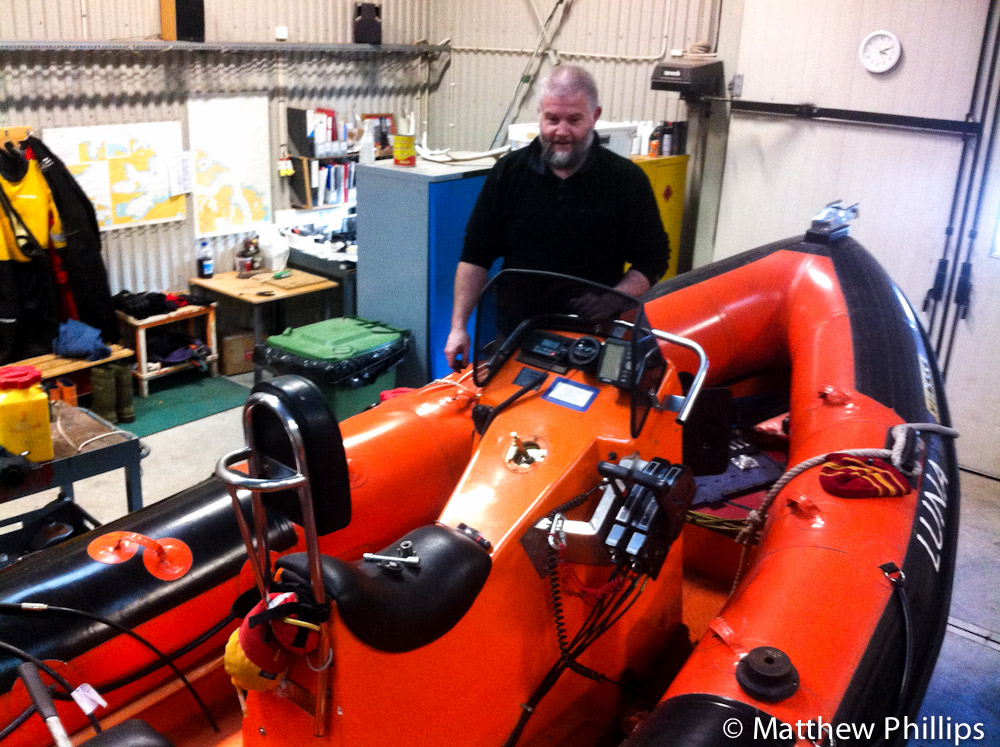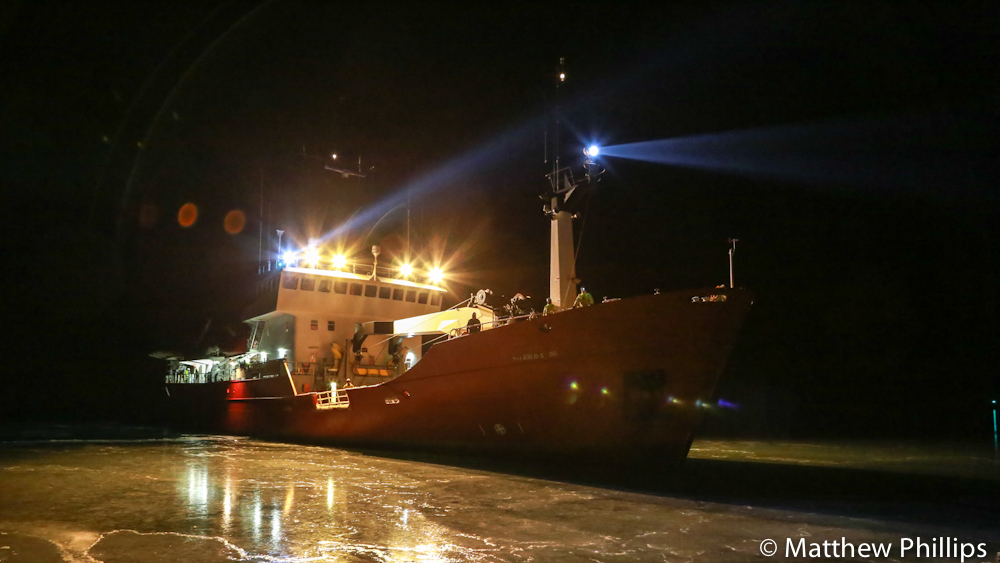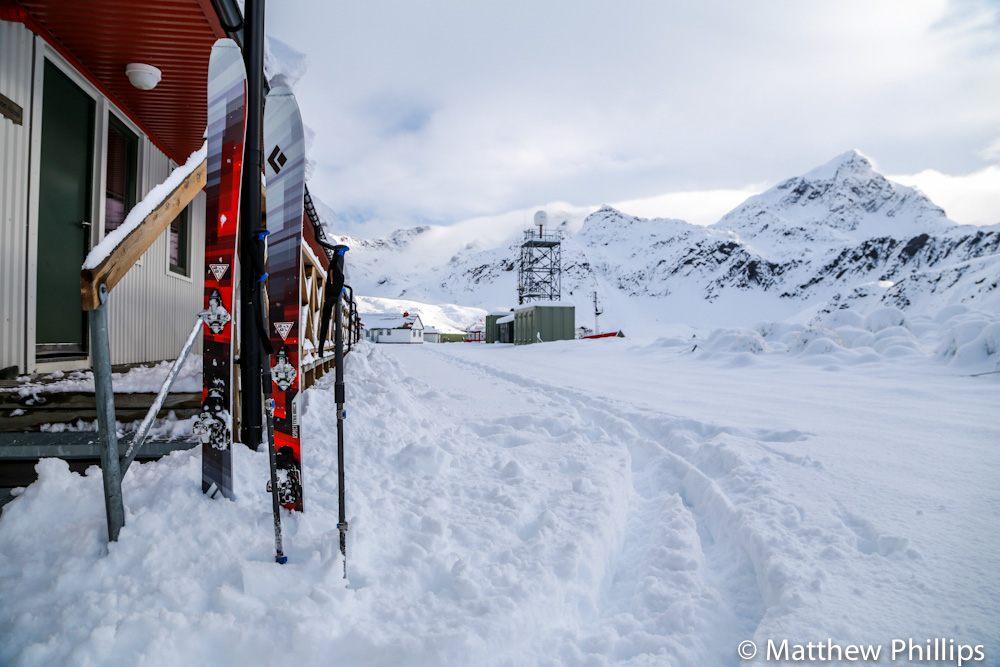July 2014
With seven BAS and one Government officer on the island life has been quiet at KEP. Everyone has stayed on base, mainly because we don’t have the numbers to let two people leave on holiday. To drop or collect people on the other peninsulars you need to do so by boat. There needs to be a back up crew to launch another boat should something happen to the first boat, plus there must be two people on base at all times. There needs to be one of the two ‘techys’ on base at all times. Various people can’t go away together i.e. the Dickie (BC) and Julie (Doc) or James (Deputy BC). I can’t go away unless there are enough boat coxes left on base, something I can rectify with training now the busy fishing season is easing off and base personnel numbers are on the rise.

Dickie, Chris and I made our way over to the hut at Maiviken for a Sunday stroll. Chris making his way towards ‘Deadman’s Cairn’ at the top of ‘Bore Valley’. This side of the pass doesn’t see much sun at this time of year so the snow is frozen solid and makes for some awkward walking. Crampons wouldn’t have been a bad idea.

Dickie enjoying a run downhill to Maivatn Lake. After slipping and sliding on ice on the way up to Deadman’s Cairn we were glad to get onto the sunny side of the pass where there was considerably less snow and ice. The Hut is well hidden in the shadows, on the right side of the lake. It’s nice to have a rest and cup of tea before heading back!

The recent warm snap had broken and melted most of the ice on the lake. What remained looked like the break up of an ice sheet… albeit on a smaller scale.
Around the middle of the month we were called on the VHF by one of the fishing ships in the area to say a crew member had broken a leg while on deck. They had a doctor on board but with limited facilities they were keen to get our help. So Julie, Jo, Daniel and myself met the ship in the bay with the intention of getting the crew member off and back to our surgery for an x-ray and possibly into plaster. I have to respect doctor-patient confidentiality here, hence the blacked out face in the picture below.

It was an interesting day! The conditions weren’t great – force 5/6 ( 17-27 knots or 18-30Mph) winds at times and a metre of swell. Luckily the ship managed to give us a ‘lee’, which is protection from the wind and swell. So we managed to get Julie and Jo on board to discuss plans and let Julie have a look at the patient. We brought out our stretcher which was winched up onto the ship to have the patient put in before lowering them the equivalent of 4 stories onto the back deck of the jet boat which I had to hold in position. If you’ve seen ‘The Hunt for Red October’ you might remember the scene where Jack Ryan (Alec Baldwin) gets lowered onto a submarine from a helicopter and ends up in the water.. well that was playing out in my head at the time.

Once the patient was on-board we got him into the surgery for an x-ray. Being the advanced first aider I was involved here too. A quick look at the broken leg showed fracture blisters just beneath the calf – a good sign it was broken. I’ve dealt with broken legs before but not one that was this unstable (in other words it was very wobbly) so we set up the x-ray machine. We don’t have any of that fancy digital stuff here so it’s old school developing in a dark room. You can see 3 of the 4 trays the film needs to pass though to get the image. For the photographers: my ISO was at 20,000 to get this (Non photographers – most day time shots are about 100 and most of my night ones are 3,000 – 10,000… so 20,000 is properly dark).

Julie making the final touches to the full leg cast. It’s a messy job but one we are getting quite good at now. X-ray (not allowed to show you unfortunately) clearly showed a broken tibia and fibula with a floating section in the tibia. A nasty break by all accounts, one that would need surgery and probably a combination of pins and plates put in. From here the patient was put back on the ship which arranged transport back to their home country for surgery, via the Falklands and S. America.

For some reason our stretcher doesn’t have lifting straps. This is what the ship rigged up in a hurry to get the patient down. Well, I’m quite geeky when it comes to this stuff so I knew how to improve this…

It’s been years since I’ve had to tie a ‘Purcell prussic’ but I managed it ok. For the non climbers a prussic is a thin (5-6mm) cord that wraps round a climbing rope (9-11m normally) and grips it when weighted, useful in rescues, ascending ropes and protecting an abseil (or ‘rappelling’ for you Americans who like to butcher the English language!). Basically, if you let go of the rope it automatically locks. A Purcell is tied back on itself and the length can be adjusted.

The prussics at the feet end are extended in this shot. Adjusting is more useful in a mountain scenario if you are lowering off a crag etc, something that’s certainly possible on South Georgia.

A closer look hopefully helps show how it slides on itself and locks/grips when weight is put on it.

Poor old “Luna’s” steering system passed away this month and took the steering cable with it. Matt and I spent the afternoon taking the old one out and replacing with a new system (device hangs below the steering wheel) and the cable that runs from the system to the engines. Being in such a remote location means learning on the job at times. It’s often a steep learning curve but we have all the manuals and a friendly mechanic (Matt) who helps out when I’m in above my head!

As we don’t have a chef on base we take it in turns to cook. Whoever is on ‘earlies’ gets up at 6am, walks around the base checking for leaks, windows are closed, my boats are still floating etc. That person makes the daily bread and then the evening meal. They don’t say grace at dinner, because nobody does! I’ve been perfecting my pizza making with fewer numbers on base.We don’t have any pre-made bases here so it’s made from scratch. I’m now fairly confident I make the best pizzas in the Antarctic, although I suspect the Italian and Argentinian bases would have something to say about that.

The finished article! One of these will feed two people comfortably. If I have time I get people to write down what they want on it and then top 1/2 a pizza for each person, so everyone is happy. An odd but increasingly popular choice is black pudding! I know what you’re thinking ‘they’ve lost it down there!’ but it works, the trick is to break it into small pieces and sprinkle it on.

It’s been a busy time with the krill ships recently and we even got James back early from his observing duties. Here two of them are ‘trans shipping’ to the one in the middle. After a week or so of fishing they come in to the bay to offload their catch to a ‘reefer’ before heading back out. Each time they do a GO goes on board to inspect everything is in order and issue a new licence.

Waiting while Jo issues a new licence on board gives James a chance to practice coming alongside. The advantage of jet drives is you don’t have to put the engine in neutral before reverse (astern). There is a constant jet of water out the back of the boat with a ‘bucket’ that slides up and down. With the bucket up, the water out of the jet isn’t obstructed. With the bucket down it’s ‘deflected’ forward towards the bow – moving the boat backwards. So if you have the bucket up on one engine and down on the other you can ‘crab’ left or right – with a little manipulation of one bucket and the helm. Sounds easy right? The tricky part is how it behaves when the buckets are down (going astern). A boat with a propeller and rudder will behave the same as a car… if you are traveling forward and turn the wheel left you turn left. If you keep the wheel in the same place and go in reverse you pretty much go back the way you came. Not so with jets, if you turn left while going forward you will go left (easy enough) but when you then put the bucket down (reverse) you carry on turning left. If that seems easy enough try working out how the boat will handle with one forward, one in reverse and turning the helm!?

A knob of South Georgia Pintails (knob is the collective noun for Pintails – bet you didn’t know that one!) on the beach at Grytviken. Their numbers have risen sharply since the rat eradication project on the Thatcher Peninsula 3 years ago. Larger birds (such as Albatross) with longer breading cycles will take longer to recover. Only the Barff peninsula and some other small areas on the east end of the island are still to be cleared. The project will start up again next year and that should be the end of the rats on South Georgia.

Despite a lack of snow it’s been cold at times and the winter skies can be dramatic. Looking NW up Cumberland Bay East towards the mouth of the bay.

This ended up being the busiest boating day here for 3 years (maybe ever). I had to put Jo on 6 different ships for inspections etc, each taking about 30-40min before moving onto the next one. This shot was taken when it just started to get dark and I had started turning on the instrument lights. There aren’t much in the way of navigational lights in the bay as you might expect, and it does tend to get quite dark. So when the GPS monitor alarm came alive with ‘position fix lost’ (basically the GPS was having a tantrum) I wasn’t too happy.

Getting darker and still the GPS was still having a tantrum. By this point I’d given up on getting it back and was plotting my way back using traditional navigation methods. Though I did still have radar I thought it would be a good test. I took a bearing to the bottom of Mt Duce (big peak on the right) from the anchor chain of the ship Jo was on. She wasn’t likely to drag anchor in these conditions. Worked out the distance to shore and calculated how long it would take at 5 and 20 knots (if there was ice, 20 knots would be dangerous as my navigation light wouldn’t pick it up early enough), so I’d know if I was about to hit land! There are ‘leading lights’ in King Edward Cove so I knew I’d be able to use them once I was a little closer to Mt Duce. Leading lights are fixed on shore and 200m apart, one behind the other, so when they line up you know you are on a safe line – elementary really! I very nearly gave the GPS a damn good thrashing when I got back but a lack of tree branches held me back… that’s a Fawlty Towers reference for readers of a certain age.

‘Doc School’ has picked up in recent weeks. Now the basics of ABC’s have been covered we are doing some more advanced stuff. We were cannulating each other a few weeks ago. Here (left) Dickie manages to get my vein first time. Once the needle is in and there is ‘flashback’ (blood) in the cannula the needle is removed leaving the cannula (basically a plastic tube) in place. And (right) attaching the syringe to flush the blood back into the vein to stop it blocking the cannula, after this you can attach a drip to provide fluids, antibiotics etc.

I’d been taught how to do this before I came South, on the BAS Advance First Aid course in Plymouth. So Dickie (who’s done it before) and I decided to try and canulate ourselves. We both managed it without too much trouble. Getting the cap on the end once the needle is out is tricky with one hand – hence the blood. I think Julie was quite impressed with our efforts!

The Pharos approaching the wharf and breaking up some sea ice – she has proper ‘nav’ lights! She’s always a welcome sight as she brings in our mail and fresh fruit and veg! She was also bringing Pat back from his 4 months leave and Rich (JCR purser) who is friends with Jo from her JCR days – so with some more numbers on base, holidays should pick up again.

Julie walks a line round the front of the jet boats. A team of people head down from base to help fix lines. I’m sure they’re rubbing it in with that light! I’ll remember that when they want to leave and need all the ice broken up (by my jet boats) so she can get out!

We finally have snow that looks like it’s going to stay! I’ve said that before and it’s been followed swiftly by warm spell. I’m hoping to get out on the skis and up some of the hills now we have proper winter conditions…

Dickie and I at the top of Deadmans Pass after a ski over to Maiviken hut. I arrived at the hut to find half the base (literally) inside having a cup of tea. (Photo courtesy of Julie Hunt)
As promised, here are a few of videos I put together recently…
First one is one I’ve been working on for a while (shortly after I left the UK to be precise) A load of footage from the summer time here, all filmed on my camera and Gopro. Some time-lapses in there too!
Here is a short video of the Mid-winter swim from last month. Threw this together fairly quickly so I could give a copy to the outgoing people before they left.
And finally a collection of all the time-lapses I took last year during my travels around the globe!
 Follow
Follow
